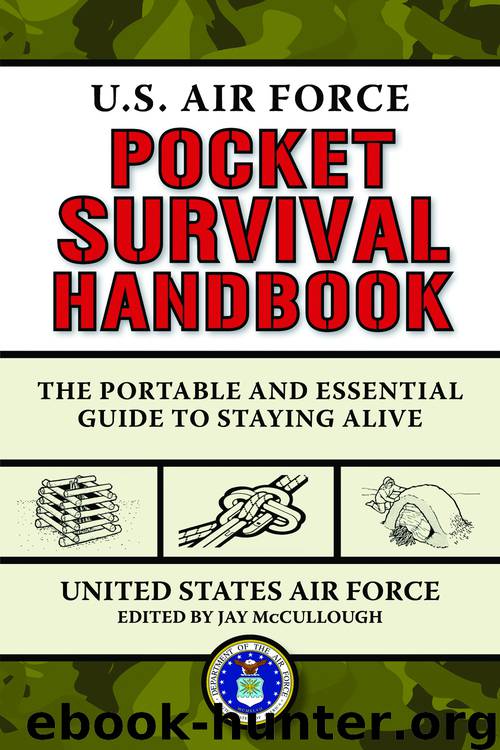U.S. Air Force Pocket Survival Handbook by United States Air Force

Author:United States Air Force
Language: eng, eng
Format: epub
ISBN: 9781620871041
Publisher: Skyhorse Publishing
Published: 2013-02-18T16:00:00+00:00
Figure 13-63. Rope Laying
(10) Making Rope with a Single Spinner:
(a) Using a Single Crank. Two people can make a rope, using a single crank. A portion of the material is fastened to the eye of the crank, as with the multiple crank. Supporting crossbars, as used in a ropewalk, are required when a length of more than 20 or 30 feet is being spun.
(b) Feeding:
-1. If the feeder is holding material under the left arm, the right hand is engaged in continuously pulling material forward to the left hand which feeds it into the turning strand. These actions, done together as the feeder walks backward, govern the thickness of the strands. The left hand, lightly closed over the loose turning material, must “feel” the fibers “biting” or twisting together.
-2. When the free end of the turning strand, which is against the loose material under the arm, takes in too thick a tuft of material, the left hand is closed, and so arrests the twist of the material between the left hand and the bundle. This allows teasing out the overall “bite,” with the right hand, thus maintaining a uniform thickness of the spinning strand.
(c) Thickness of Strands. Equal thickness and twist for each of the strands throughout their length are important. The thickness should not be greater than is necessary with the material being used. For a grass rope, the strand should not be more than one-fourth inch diameter; for coarse bark or palm, not more than one- eighth or three-sixteenth inch; and for fine bark, hair, or sisal fiber, not more than one-eighth inch.
(d) Common Errors in Ropemaking:
-1. There is a tendency with beginners to feed unevenly. Thin wispy sections of strand are followed by thick portions. Such feeding degrades the quality of rope. Rope made from such strands will break with less than one-fourth of the tensile strain on the material.
-2. Beginners are wise to twist and feed slowly. Speed, with uniformity of twist and thickness, comes with practice.
-3. Thick strands do not help. It is useless to try and spin a rope from strands an inch or more in thickness. Such a rope will break with less than half the tensile strain on the material. Spinning “thick” strands does not save time in ropemaking.
(e) Lianas, Vines, and Canes. Lianas and ground vines are natural ropes, and grow in subtropical and tropical scrub and jungle. Many are of great strength and useful for braiding, tree climbing, and other purposes. The smaller ground vines, when “braided,” give great strength and flexibility. Canes and stalks of palms provide excellent material if used properly. Only the outer skin is tough and strong, and this skin will split off easily if the main stalk is bent away from the skin. This principle also applies to the splitting of lawyer cane (calamus), palm leaf stalks, and all green material. If the split starts to run off, bend the material away from the thin side, and it will gradually gain in size and come back to an even thickness with the other split side.
Download
This site does not store any files on its server. We only index and link to content provided by other sites. Please contact the content providers to delete copyright contents if any and email us, we'll remove relevant links or contents immediately.
| Camping | Excursion Guides |
| Instructional | Walking |
In a Sunburned Country by Bill Bryson(3506)
Annapurna by Maurice Herzog(3446)
How to Read Nature by Tristan Gooley(3290)
Dangerous Girls by Haas Abigail(2994)
SAS Survival Handbook by John 'Lofty' Wiseman(2694)
The Lost Art of Reading Nature's Signs by Tristan Gooley(2659)
In the Woods by Tana French(2560)
The Stranger in the Woods by Michael Finkel(2486)
Food and Water in an Emergency by Food & Water In An Emergency(2369)
Guns, Germs and Steel by Diamond Jared(2332)
Everest the Cruel Way by Joe Tasker(2307)
Wild: From Lost to Found on the Pacific Crest Trail by Cheryl Strayed(2227)
Sea Survival Handbook by Keith Colwell(2212)
Backpacker the Complete Guide to Backpacking by Backpacker Magazine(2210)
Trail Magic by Trevelyan Quest Edwards & Hazel Edwards(2143)
Ultimate Navigation Manual by Lyle Brotherton(2137)
Welcome to the Goddamn Ice Cube by Blair Braverman(2015)
Birds of the Pacific Northwest by Shewey John; Blount Tim;(1942)
The Last Flight by Julie Clark(1924)
